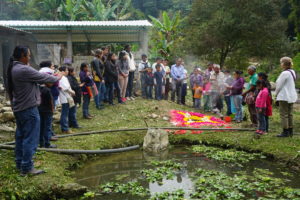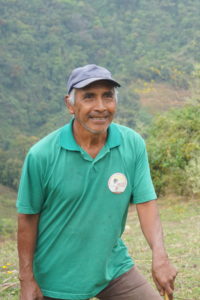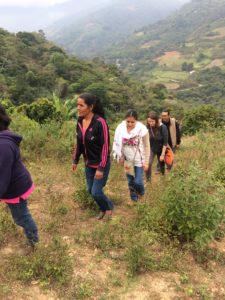
“We eat what we plant. What we eat comes from our own labor. It’s healthy,” explained Don Carlos, a Zapotec campesino living in the village of Santa Gertrudis deep in the Sierra Juarez mountains of Oaxaca, Mexico. “Before we ate processed food and we didn’t know what was in it. We are also really blessed to have clean, fresh water.”
Sitting just 40 feet from the fresh flowing mountain water eliciting Don Carlos’ gratitude and eating a nutritious bowl of organic farm-raised Tilapia soup and fresh tortillas, the full impact of the transition back to indigenous food ways he was describing was palpable.
Neon Cruz, another campesino who was born in Santa Gertrudis and began farming at age 12, explained how it used to take him 8 hours a day to cultivate food on two plots of land deep within the lush mountains. First, he would trek 2-3 hours up the mountainside to the nearest market to buy expensive chemical inputs. Then he’d struggle to carry 50 kilos of these agrochemicals on his back as he hiked for two hours on most days from plot to plot to grow his crops, now doused in agrochemicals.
But all of that was before he, Don Carlos and the 30 families living in Santa Gertrudis learned about The Union of the Organizations of Sierra Juarez, or UNOSJO.
On a bright winter morning, the two men joined most of the rest of the villagers in taking a rare break from their daily schedules of planting seeds, cultivating the land, tending to their cows, pigs and fish, cooking, cleaning, and caring for their families to welcome the WhyHunger staff, a group of supporters who are employees of Hard Rock Interna
tional, and our hosts from UNSOJO to their remote village.
One by one the villagers shared their stories and experiences of working with UNOSJO, an Indigenous-led organization that addresses the critical needs of the local Zapotec families through programs ranging from sustainable food production and women’s rights, to protecting their indigenous territory and providing legal assistance.
Well-known in Mexico and internationally for their pioneering work to expose the contamination of local corn varieties by GMO crops, UNSOJO has been organizing and leading the resistance for years. They’ve taken legal action to block the GMO crop invasion, started local seed banks and encourage farmers to grow traditional varieties of maize. Now they are organizing community-led actions and pushing for legal protections against mega projects, like the hydropower dams, mineral extraction and mining operations being carried out illegally on their territory, which threaten their access to clean water, good soil and their very way of life.
“We are not activists; we are defenders of human rights,” explained Aldo Gonzalez, an Agronomist and leader in UNSOJO’s Indigenous Rights Sector.
To protect indigenous rights, UNOSJO documents abuses to children, women, entire communities and the natural resources they depend on, and offers workshops on the legal, economic, social and cultural rights, like the rights to food and health. They facilitate learning exchanges, farmer-led trainings and provide technical support to build capacity. They work to spread information about actions, threats and opportunities via social media, posters, word of mouth, community radio and a bi-annual magazine they publish. They’ve teamed up with several other local organizations to establish the Collective of Oaxaca and Defense of the Territory as a way to strengthen their collective resistance to the growing threats to their sovereignty.
UNOSJO’s approach is driven by the indigenous collective view of life, where each individual member of the community has “Tequio” or the capacity and responsibility to contribute to the community. Through collective leadership and community organizing they maintain access to the water, land and the resources they need to ensure that everyone can live a dignified life with enough nutritious food to eat. Oswaldo, the coordinator of UNOSJO’s Campesino-a-Campesino program, explained their shared goal of “el buen vivir” or “living well” that defines the indigenous cosmovision of “living well, not better.”
“It’s not a vision of charity; it’s about indigenous autonomy, the indigenous cosmovision,”explained Luz Leila Peres a la Vez, incoming UNSOJO Treasurer. “UNOSJO teaches people new practices to be self-sustaining and less dependent on agrichemicals and commercial seeds, and helps them produce healthy food.”
To illustrate this point, campesino Neon Cruz led our group up into the mountains to view his plots of land and see the benefits of UNSOJO’s partnership up close. Now, with the agroecological practices he has learned, Neon no longer has to buy and lug the heavy agrochemicals around his fields. He only carries a 3-liter spray bottle to disseminate organic inputs – like the supermagro that UNSOJO farmers taught him how to make—which he creates himself, without additional costs, to grow his food.
“There are fewer insects and fungus that attack my crops, now,” explained Neon. “The flavor of the food is better. The grains cook better; they’re less coarse…. I see the results!”
UNOSJO also supported Neon to build a water tank, get a cow and even participate in a shared learning exchange with Brazilian farmers from Popular Peasant Movement (MCP). Now, Neon is teaching others how to use agroecology practices through campesino-a-campesino trainings. This farmer-to-farmer methodology, which relies on shared learning and shared experience, helps to efficiently scale out agroecology across the territory.
As Oswaldo, the coordinator of UNOSJO’s Campesino-a-Campesino program explained, “An agronomist can’t go to a farmer and say ‘you should do this.’ He has no real reference. The farmers have such little resources, they can’t take risks or try new things. But when a farmer has succeeded [for himself], he can teach another farmer.”
Campesina Victoria Cruz, whose corn, beans and squash are layered up the hillside directly above Neon’s plot, explained that, as a single mother, she often relies on offering and receiving help from other farmers in the village. Her Milpa, a plot of land dedicated to the indigenous practice of inter-planting of beans, corn and squash, provides food for her children and space for her to experiment with the agroecological practices she is learning from UNOSJO. She just started growing potatoes, indigenous corn and coffee and, for the first time, is now exceeding production and able to sell in the nearby market in Talea de Castro.
As we finished touring these robust plots dotted across the mountainside and meeting with farmers and their families, the impact of UNSOJO’s support in strengthening the community at Santa Gertrudis was clear.
“We’ve accomplished a lot together as a group,” Don Carlos said with a sense of pride and hope. He told us that the villagers are getting better and better at organizing themselves. They started with organic compost for corn, beans and other plants. Next they began intensive fish farming with tilapia. Then they got the cows. “All of this happened because of UNOSJO’s support.”
Even with the strong social fabric of their community and the partnership of UNSOJO, the villagers are up against real threats. They are working to build international solidarity to amplify the threats from climate change affecting their growing season, multinational companies invading their territory, and spill off from mega projects contaminating their land, water and soil.
“You can help us by sharing stories and letting people know how hard it is to defend the land and territory,” said Oswald.
WhyHunger will continue supporting indigenous communities as they strive to ensure their families can live well.













